Wednesday, January 31, 2007
This is the first of two back-to-back business trip that take me to two different conferences.
Got to Pearson in the morning, and took the just over one hour flight to New York City's LaGuardia airport from there. I didn't have a window seat unfortunately, but I had a great view of flying over central Manhattan, looking down at the Empire State building as we were coming in for a landing. The flight was smooth as silk up until the end, when crosswinds jostled the plane side-to-side, but the landing was clean and I soon got off and grabbed a yellow cab to head to my hotel downtown.
Got to the Grand Hyatt, which is just beside Grand Central Station. Lots of marble and brass everywhere in the main foyer to the building. Am here for a conference being hosted by SDL, a firm that provides localization software and associated tools. I can't get into the details of why I am here as that is strictly work-related, and I hope that this will not be a "hard sale" conference, though I have been assured that it will not be.
The hotel room was clean, if somewhat more spartan in spots than what I would have expected for the price being paid. I guess that's New York for you. The small safe in the room doesn't work, (the display saying "BATT" in big red LED letters; batteries run down presumably) and they were obviously working on the plumbing as I couldn't flush for the first hour or so I was there (this thankfully didn't last). The bed was big and comfortable, and while there wasn't any view to speak of outside the window, at least the quiet promised a good night's sleep.
Answered all of my work emails on my BlackBerry, and decided to venture out to do some "museum-ing" I wanted to do. Got in a cab heading south and I asked the driver to take me to the Brooklyn Museum.
The Brooklyn Museum has a world-renowned collection of Ancient Egyptian antiquities, and has the second-best collection in NYC. It has a lot more besides, but that was what I was most interested in seeing, especially a couple of pieces I knew we're in the collection.
I was not to be disappointed. I entered the main gallery, camera in hand (with the flash turned off), and headed towards the Predynastic and Old Kingdom displays.
The initial and signature piece of the collection is a predynastic figure of a woman with outstretched hands and a bird-like beaked face. There are a couple of similar pieces from the R.O.M.'S collection as well. No-one knows the intent of these figurines, which have been interpreted variously as "mourning women" or as fertility symbols.
One of the real jewels of the collection is an alabaster statuette of the young pharaoh Pepi II sitting on the lap of his mother the Queen regent. I knew the piece was here thanks to the work I had done on the history of this pharaoh for Wikipedia, and was looking forward to seeing the piece in person. It is much larger than I expected it to be, just under an arm's length tall. It is one of a very small number of three-dimensional representations of this pharaoh, and the photos I have previously seen of this piece manage to convey the serene look on the face of the queen, but not of the slightly grumpy and put-out look of the young king sitting on her lap.

Alabaster statuette of Pepi II sitting on his mother's lap
I was disappointed in not finding a statue of Ahmose I, another pharaoh I had co-written a Feature Article for Wikipedia on, instead finding an empty plinth where it had been. Again, another case of an object for which there are few examples, so I was disappointed at its absence.

No statue head of Ahmose I here
I exited the Old Kingdom displays and doubled back to the galleries heading the opposite direction. I started out at the Amarna galleries, with pieces dating to the time of the "heretic" pharaoh Akhenaten, who turned a multi-theistic culture into something approaching monotheism, worshiping the sun disc, called the Aten. The striking thing about this period is the distinct change in the art from this time, dispensing with much of the stiff formalism inherent in much Ancient Egyptian art and instead moving to a more languid style, sometimes breaking with various established conventions. I was pretty much spoiled when I visited the Egyptian collection in Berlin, as it has a large room devoted entirely to Amarna-era masterworks, and while there's nothing to rival the famous bust of Nefertiti, there are some interesting pieces here as well
The first piece I saw was the so-called "Wilbour Plaque", named after the former owner who donated the piece to the museum. It depicts an Amarna-era pharaoh (which narrows it down to Akhenaten, his successor Smenkhare, or possibly Tutankhamen -- I would favour the first identification in this case), along with Queen Nefertari. What makes this piece interesting is that the faces were never done as part of a larger relief, now lost, but instead as perhaps a sort of guide for other relief sculptors, the hole at top center made deliberately for hanging the piece on someone's wall.

The Wilbour Plaque, depicting an Amarna-era pharaoh and Nefertiti
Beside this was a larger piece that depicted the pharaoh Akhenaten. What I found most interesting about it was the systematic way in which the cartouches bearing his name had been chiseled away at, reflecting the destruction that was visited up most of the pieces in the room, many in a fragmentary state.

Detail from a relief depicting Akhenaten, with his names in cartouches chiseled out
Much of the rest of the room was devoted to reliefs from Amarna, many depicting the royal family and others showing more pastoral or everyday themes. One of the more instructive was a pair of reliefs depicting Nefertiti, the top one from the early part of the Amarna period, the bottom one from the end of that era. The top one depicts a face with highly exaggerated features, with large eyes, a straight nose and full lips. The bottom one is more subdued in style generally. The extensive text beside these pieces suggests that the change in style was due to a new successor to the title of Chief Royal Sculpture, specifically the same Thutmose who created the famous colourful Nefertiti bust I saw a couple of months back in Berlin.

Two Amarna era reliefs depicting Nefertiti, from the early and late Amarna periods
One in particular that struck me as interesting was a particular talat showing a team of horses pulling a chariot. Egyptian reliefs are often "busy", filling up every available space, but this team of horses has an empty space it is evidently heading into, giving more of an impression of speed than it would otherwise be if the space was filled with text. And one of the horses is looking straight at the viewer, another thing simply not seen in Ancient Egyptian reliefs, which always have faces and heads depicted in profile.

Amarna relief depicting chariot and its team of horses, one of which looks straight at the viewer
More to come...
Labels: Ahmose I, Akhenaten, Amarna, Ancient Egypt, BlackBerry, Brooklyn Museum, Grand Central Station, Grand Hyatt, Manhattan, Nefertari, New York City, Pepi II, SDL, Smenkhare, Tutankhamen, Wilbour Plaque
Sunday, January 21, 2007
In my spare time I have been occupying myself lately on Wikimedia, which is the open source repository for multimedia files, and a companion (and complementary source of info) to Wikipedia. I had been organizing pictures I had taken just before Xmas at some of the Royal Ontario Museum's galleries on the site. In the end I managed to get a good collection together of most of the more significant items on display in the Egyptian and First Nations galleries there.
<flashback>Back in September 2005 I heard on the radio that the dinosaur gallery was going to close down for renovations. So I made a point of heading there with my camera in hand as I knew that what they were likely to replace the gallery with would be a lot different. Undoubtedly improved and updated, but I wanted to capture that the essence of what was undoubtedly a dated display, reminiscent of the state of the art circa the late 60s. There were the small dioramas featuring attacking dinosaurs set at about knee-height for me, designed for young kids to peer at and ponder. Then there was the display of a dino digger at the Hunter Quarry, his jack hammer now a museum-piece, and a fine layer of dust covering everything. Or the gallery of primate evolution, featuring black and white pictures of people from many different cultures arranged on branches of a tree of life, with a picture or two of a hippie chick solidly dating the display to another era. Or the full-sized dioramas featuring the bones of animals posed around a section of a mock LaBrea Tar Pit, clawing away at the unfortunate animals that had already succumbed. I took pictures of the lot, with the intention of putting together a mini-gallery on my own blog site at some point in the future.</flashback>
So I have all of these photos from the old dino gallery. I had even invested the time into putting photo-collages together of some of the larger displays. So I found the original pictures I had shot, did some judicious cropping and retouching of them in PhotoShop, and posted a bunch of them as the preferred PNG format to Wikimedia. Voila! an online gallery of what used to be on display at the ROM.The sole exception was an animated GIF file I had constructed of a peephole display showing an Australopithecus skull "morphing" using light and mirrors into the face of living female of that long-dead primate.
If you are interested in a tour of the old dino gallery at the ROM, go to (url) to see what I uploaded. Until the museum opens the new dino gallery (supposedly for sometime later this year) this will have to do.
Labels: Ancient Egypt, First Nations, Royal Ontario Museum, Wikimedia Commons
Saturday, November 04, 2006
I made the short walk to my hotel from the Pergamon Museum, and promptly put the rechargeable lithium battery in its charger. Then I went back downstairs and headed off to get a quick bite to eat. The museum was set to close at 6pm so I let the battery charge for about an hour and then made my way to the Altes Museum, where the Ägyptisches Collection is being housed temporarily while reconstruction work continues on the Neues Museum, where the whole of the collection will eventually be housed -- its original venue in Berlin prior to WWII and the political division of Germany.
The Egyptian collection is located on the top floor of the building, where I paid my admission, doffed my coat and made my way inside.
Despite the lateness of the day, the museum was still busy, though not as busy as at had been at the Pergamon earlier in the day.
The first room is filled largely with the busts and statues of royal or related images. Here's the photo-tour:
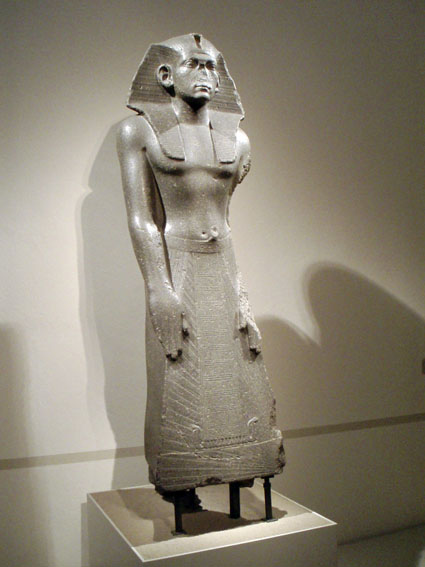
Statue of a Pharaoh Just Inside the Entrance
This is the first thing you see when you make your way through the entrance to the museum. A crowd of people gathered around it in a mix of awe and appreciation.
Receiving much less recognition was this small, impassive statue described as a baboon god. But in terms of history, this was arguably much more significant than the grand, kingly statue beside it, as it has, scratched in its base the catfish and hammer glyphs that represent the pharaoh Narmer, who is generally recognized as the first pharaoh of Ancient Egypt.
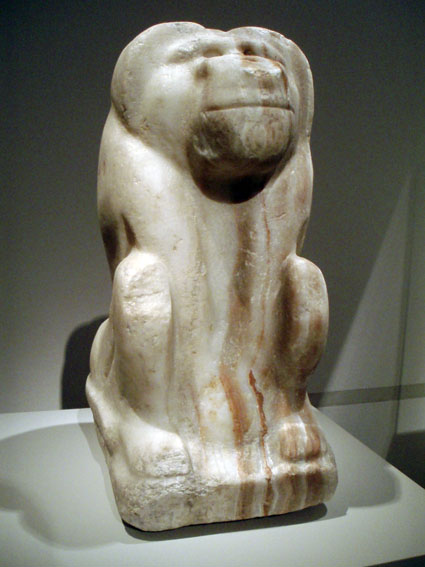
Baboon God Statue with Pharaoh Narmer's Name Etched in its Base
Elsewhere in the room were other famous faces of various pharaohs, most dating to the time of the New Kingdom.
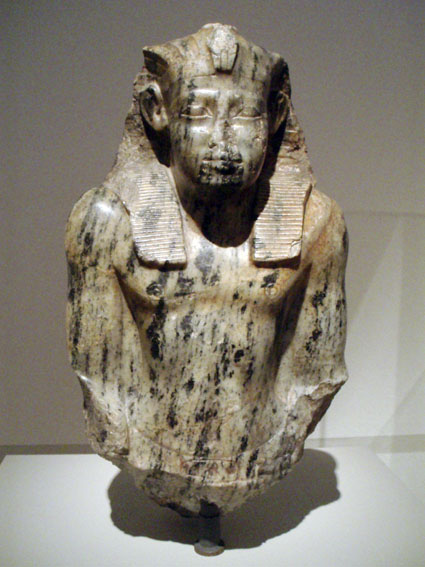
Bust of Sesostris I
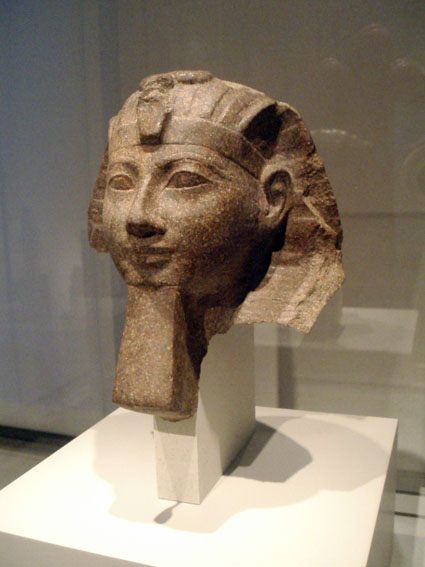
Fragmentary Statue Head of Hatshepsut
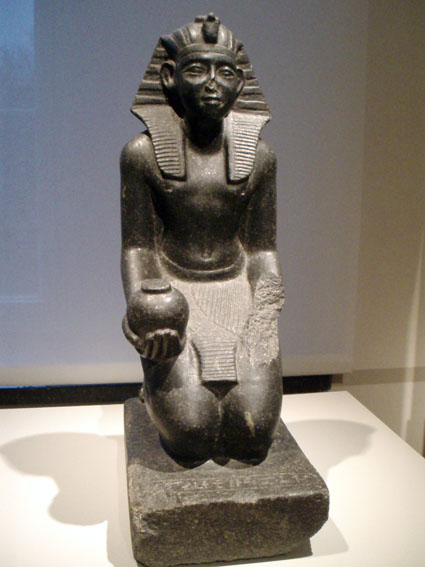
Kneeling Figure of Sobekhotep V
There is a division in the room and then you see a collection of statues primarily of private citizens, some with their families, others obviously important officials.
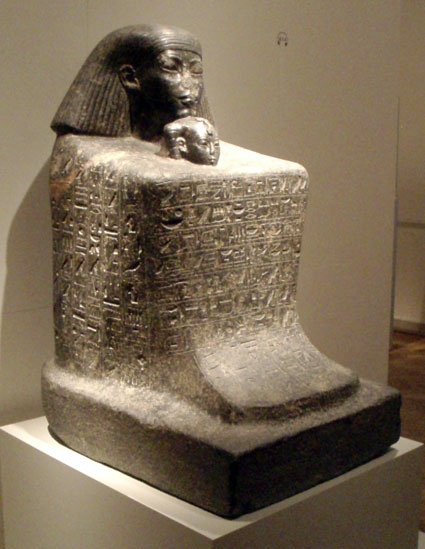
Block Statue of Senemut and Princess Neferure
This particular block statue (a popular form in Egypt used primarily by non-royals) struck me as particularly interesting, as the head of the young royal girl was also represented. This turned out to be a depiction of Senemut, who was tutor to princess Neferure, who was the daughter of the female pharaoh Hatshepsut. He is also credited with being the architect of several of Hatshepsut's more impressive buildings, including her funerary complex -- and also possibly the pharaoh's lover.
There is an interesting mix of other pieces in the room, a real jumble of largely non-royals from several different eras and styles.
For example this late period statue of an unnamed official faces the head of Khaemwaset, one of the sons of Ramesses II.
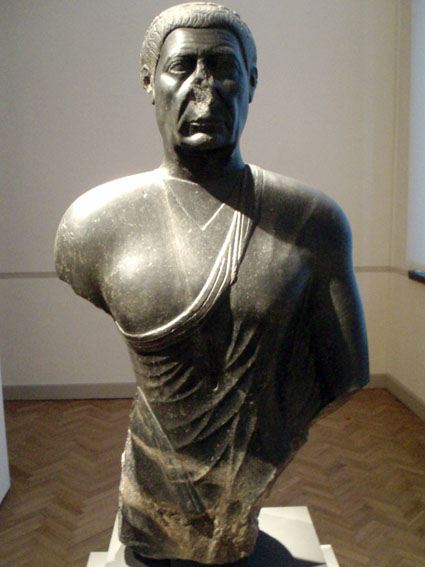
Late Period Egyptian Official
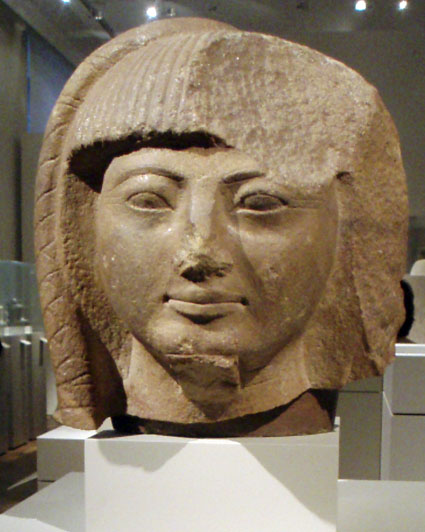
Prince Khaemwaset
The real gem in this part of the room was the famous "Berlin Green Head", a finely crafted head carved in greywacke of some unknown late period official.
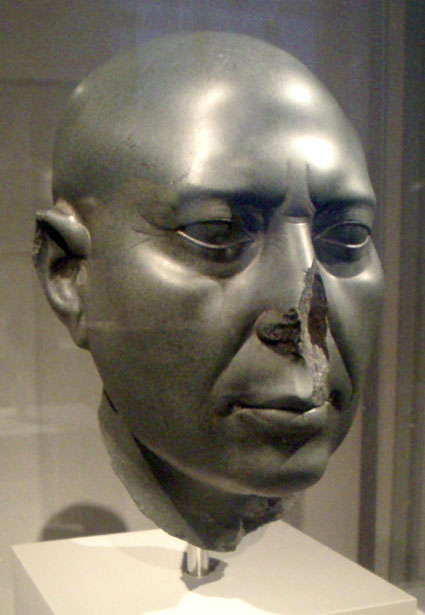
The Berlin Green Head
Just beside this last piece is the entrance to the hall containing the highly expressive art pieces from the Amarna period, which is recognized as the highlight of this museum's collection.
A German-led expedition went to the long abandoned city of Amarna early in the last century, which was the seat of power for the "heretic" pharoah Akhenaten, who created a monotheistic cult of the disc of the sun god, called Aten. This is the first piece one sees when you enter the room: a broken relief depicting Amenhotep beside a falcon-headed Aten figure. He would soon after change his name to Akhenaten.
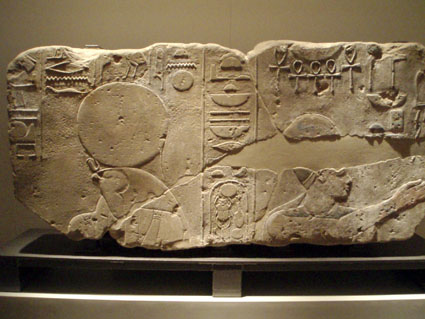
Falcon Aten and Amenhotep IV
The next depicted was the next thing that grabbed my attention: the head of Queen Tiye:
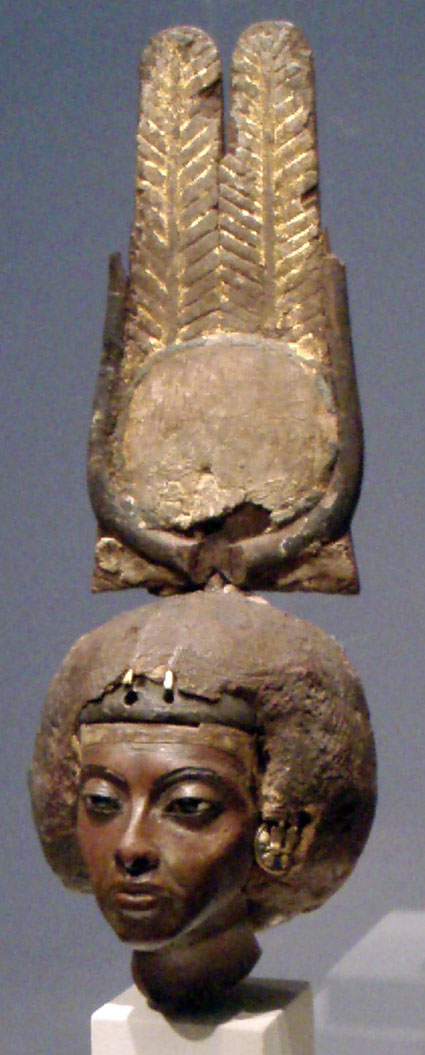
Head of Queen Tiye
This image has been endlessly reproduced, but I was surprised by its size it's small. I had always thought it was life-size or near it, but the head is perhaps half life-sized, which makes the fine features of Queen Tiye, very much an individual, all the more impressive. Can't help thinking she must have been formidable in person.
What follows are several plaster heads of Akhenaten and members of his court, presumably artist's studies that were abandoned along with the rest of Amarna upon the death of the pharaoh.
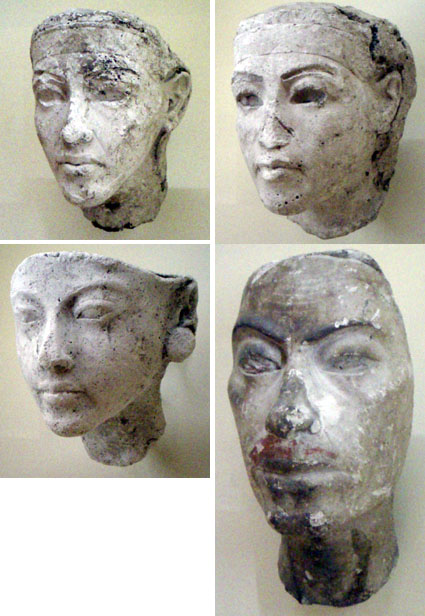
Plaster Heads of Akhenaten (x2), Nefertiti and Aye
They reminded me of the so-called "reserve heads" I had seen at an exhibition of Old Kingdom objects a few years back, and while that wasn't the intention here, Akhenaten was clearly well supplied with plenty of them for his ba-soul (so the belief went) to find refuge in.
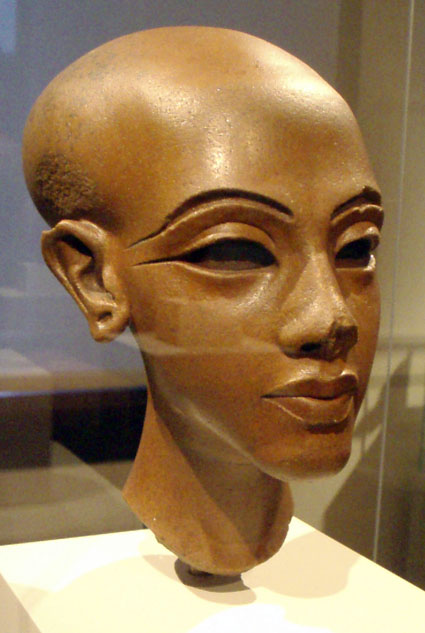
Elongated Head of an Amarna Princess
Theories have abounded on the strange shape of Akhenaten's face as well as though of his family, including such exotic diseases as the "elephant man's disease" and Marfan's syndrome, but after looking at all of the lifelike busts, and the fact that the more exaggerated appearances tend to date to the later part of his rule, I can't help but think that this was a stylistic difference, intended to make the king and his family appear "otherworldly", something recognizably human, but exaggerated Don't get me wrong, am not talking the silly flim-flammery of invoking Velikovskian aliens, but there has always been a tendency in art to emphasize certain physical features (just think of any of the pre-historic "Venus" figurines of Europe as an obvious example) and I would guess that the change in appearance has much more to do with exaggeration (and possibly caricature?) than any actual physical ailment. The mummy of Tutankhamen showed that his head was not markedly elongated, and he was almost certainly a descendant of Akhenaten. Until Akhenaten's mummy is found (or identified) his ba-soul will have the last laugh.
The centerpiece (literally) of the Amarna exhibit is the famous bust of Queen Nefertiti.
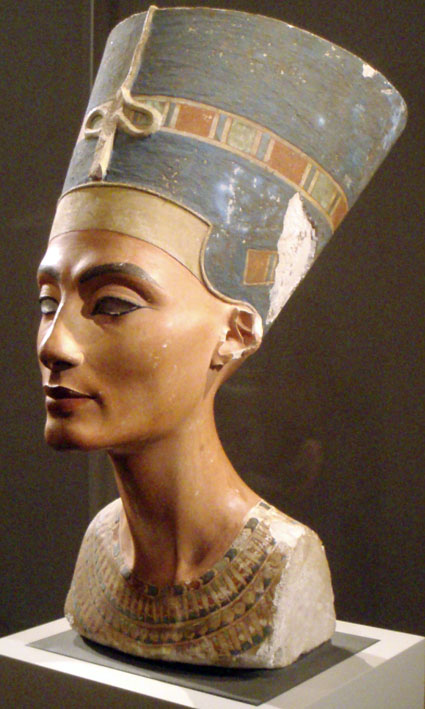
Bust of Queen Nefertiti
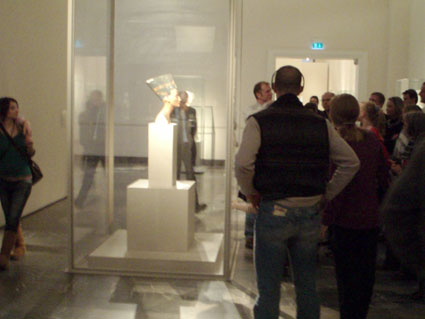
People Looking at Nefertiti Bust
A small crowd had understandably gathered around it, with a tour guide explaining things in German. The bust is striking, and so realistic that it must have been based on life -- not a homogeneous, highly idealized image but clearly that of an individual. Which is why this has become a singular work of art which has been seen to typify that of Ancient Egypt, when in fact the opposite couldn't be more true -- it is a work from a very specific era when individual artistic expression was allowed to flourish. What came before and after did not express the same artistic range seen in the Amarna period.
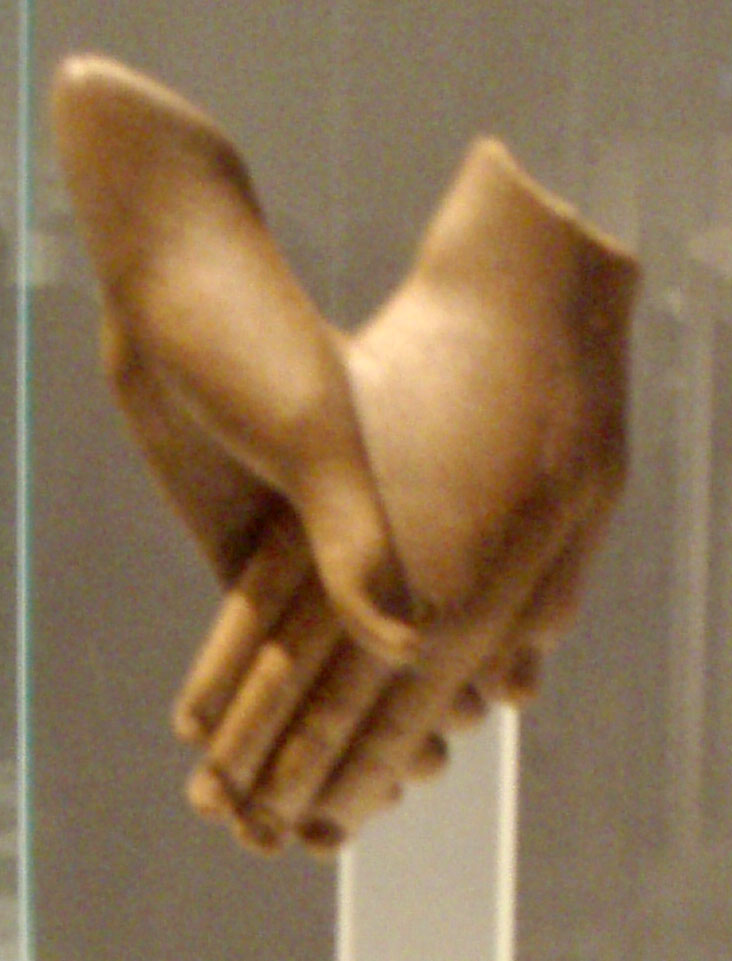
Clasped Hands from an Amarna-Era Statue
There were various other pieces dotted about the rest of the room, but this piece nicely concluded my visit: two hands holding each other, presumably of Akhenaten and Nefertiti, all that is left of some larger statue. At once the fragment is tender and evocative, though still clearly Egyptian in style.
After the highlights of the Amarna room anything else that would follow it would seem anti-climactic, but I was taken aback at the display in the next room of a number of papyri I knew the Berlin museum had these, but I didn't expect to find them on display, even under the low-light conditions present in the room. Some of them were famous, such as the Papyrus Westcar, in which fantastic, magical tales are told to Khufu, the builder of the Great Pyramid. Then there's the "Debate Between a Man and his Ba-Soul", which is basically the first known piece of writing that deal with the topic of suicide (the Ba-soul suggests that it is not such a great idea). Then there are more colourful treatises detailing a soul's passage to the underworld. I took plenty of (non-flash) photos, and will hopefully be able to stitch some of them together later in PhotoShop.
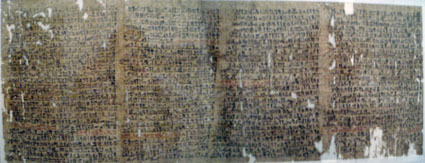
Westcar Papyrus Photo-montage (if you look closely you can see me taking the picture in reflected glass, twice

"Guide to the Afterlife for the Custodian of the Property of the Amon Temple Amonemwidja with Symbolic Illustrations Concerning the Dangers in the Netherworld"

"Guide to the Afterlife for the Custodian of the Property of the Goddess Mut Sesech with Symbolic Illustrations Concerning the Dangers in the Netherworld"
The doorway to the next room was framed by a series of mummy masks.
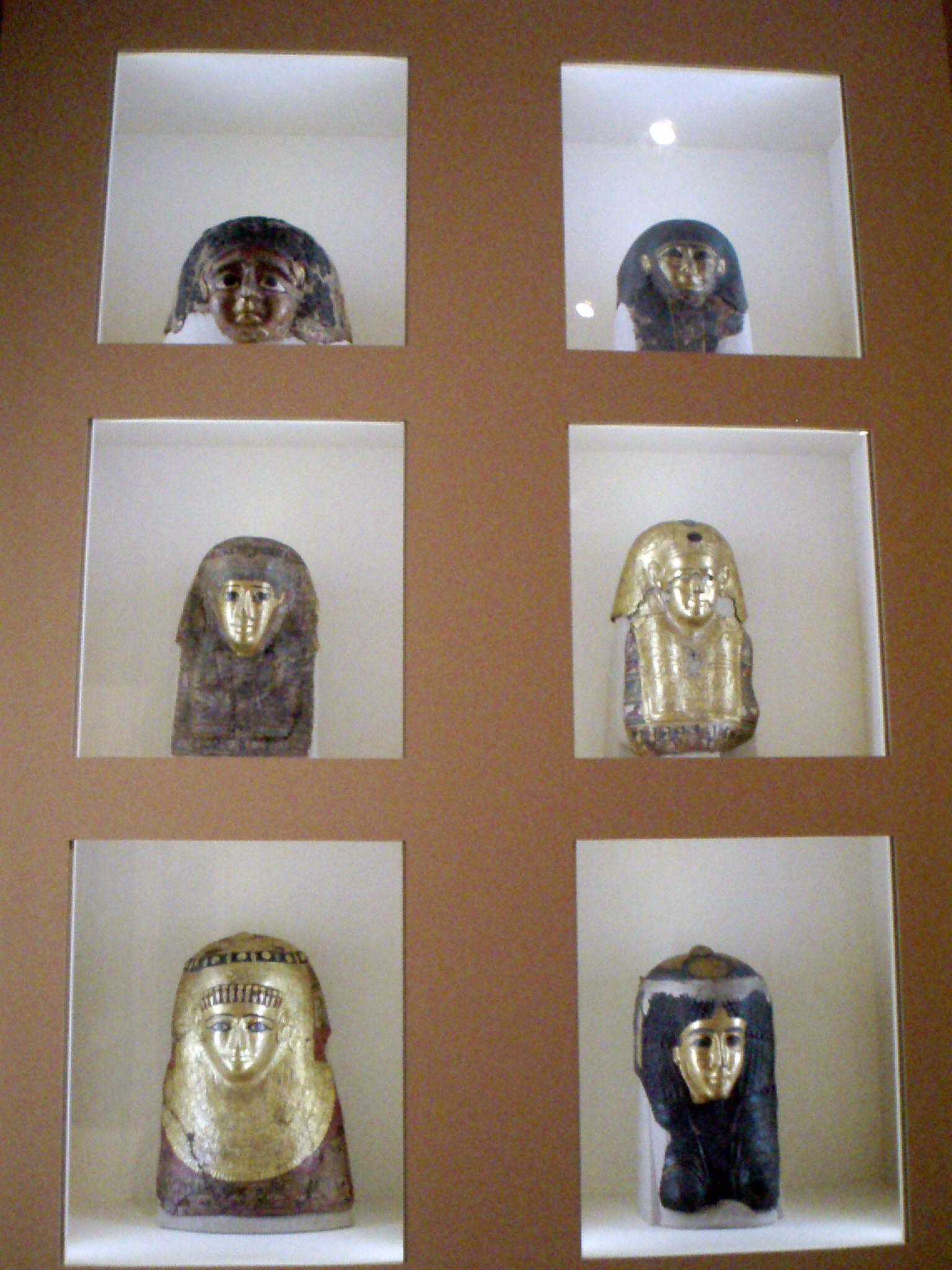
Mummy Masks Flanking Doorway
The room that followed contained several late period mummy cases and mummies (all wrapped up), including a family dating to the Greek or Roman period. These are the ones that include a painted portrait of the individual family member as they appeared in life. Couldn't help but think of what my two young daughters would think about seeing mummies of children their age or younger.
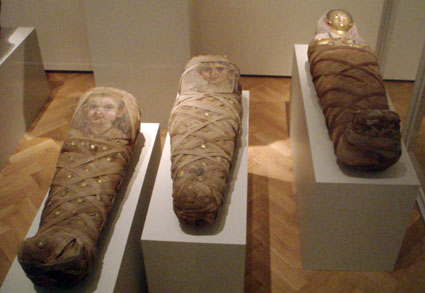
Mummies of Late Period Children
Was getting near the end of the Egyptian exhibit at this point, and the most impressive thing at the conclusion were a pair of statues of full-size lion headed goddesses Sekhmet, both clutching a very large ankh, the symbol of life, in their right hand. This particularly formidable-looking pair of goddesses were believed to protect against illness, and I had recently finished reading an article about their construction during the reign of Amenhotep III, who constructed a vast number of these statues. The thinking was that they were made during a time of repeated plagues, these statues ultimately a vain attempt at a preventative health measure against the pestilence which struck the land.
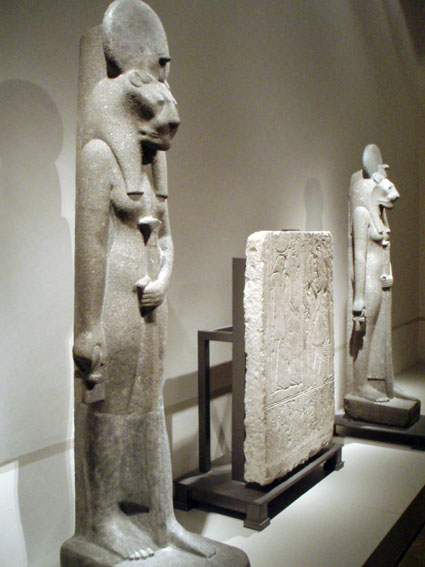
Pair of Sehkmet Statues
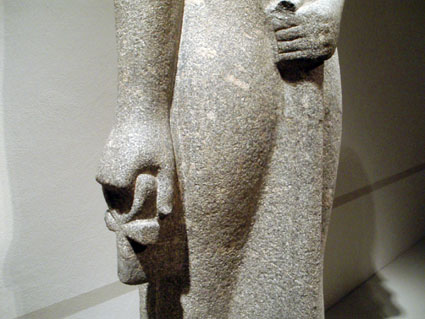
Close-up of Ankh
I thought that that was pretty much it, but it turned out that there were more Ancient Greek and Roman pieces downstairs. Entrance was through a circular atrium filled with statues of the gods. There was a skylight at the top of the dome which would have filled the atrium with light on a clear, sunny day, but it was late afternoon and the otherwise unlit room was gloomy and did not lend itself to picture-taking.
All of the explanatory text in the subsequent exhibit halls were exclusively in German, so I did not linger long over much of the rest of the exhibits. There were a few interesting busts of a few famous personages I either recognized directly or was able to figure out from the German labels.
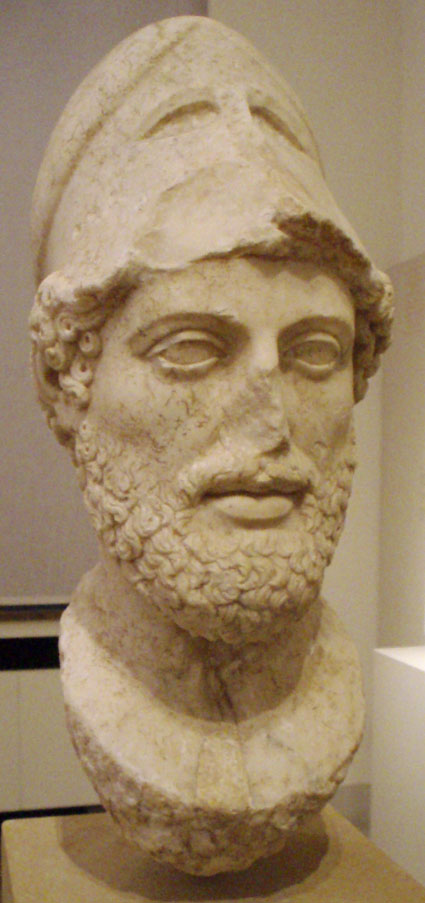
Bust of Pericles
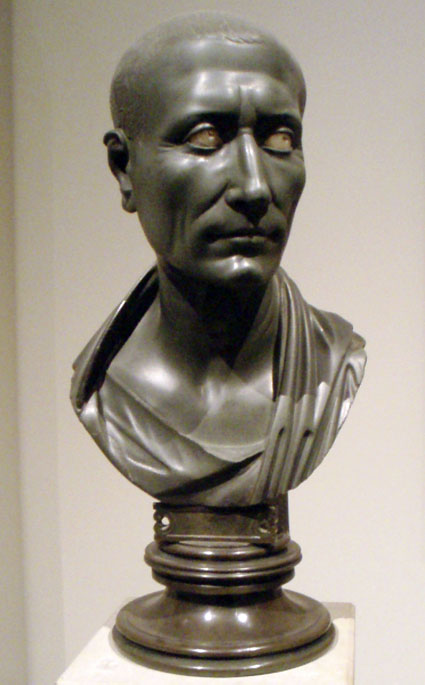
Doleful Looking Bust of Julius Caesar
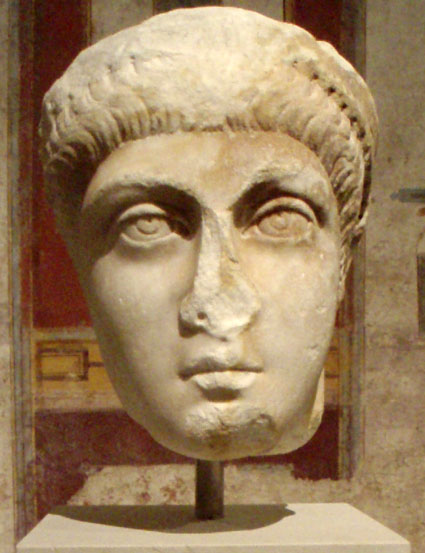
Bust of Emperor Arcadius
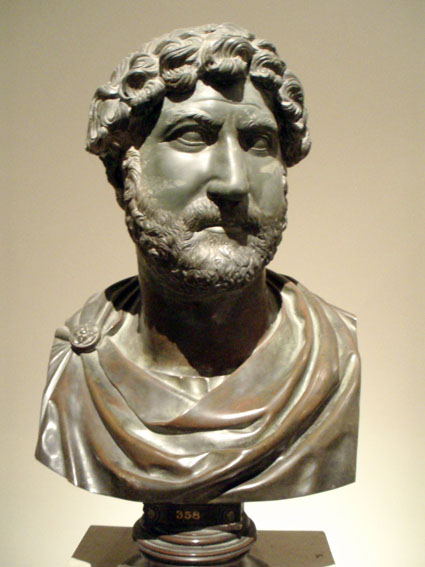
Bust of Emperor Hadrian
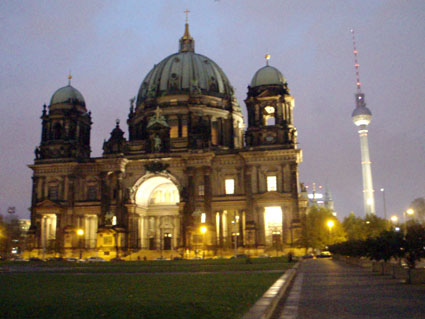
Berlin Cathedral and the the Fernsehturm (TV Tower)
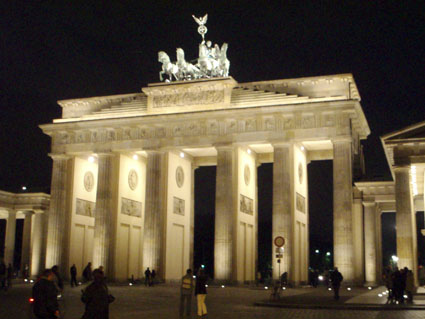
Brandenburg Gate at Night
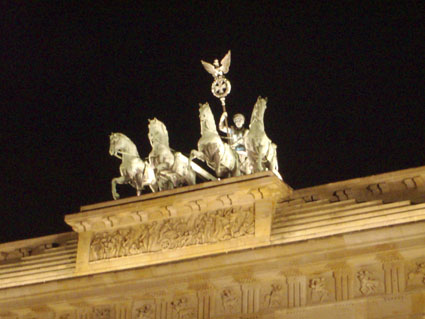
Close-up of the Quadriga on Top of the Brandenburg Gate
Labels: Akhenaten, Altes Museum, Amarna, Ancient Egypt, Berlin, Brandenburg Gate, Hadrian, Hatshepsut, Khaemwaset, mummy, Narmer, Nefertiti, papyrus, Pericles, Quadriga, reserve heads, Sekhmet, Senemut, Tiye
Subscribe to Posts [Atom]
